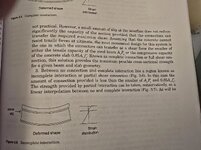CivilSigma
Structural
- Nov 16, 2016
- 106
I'm studying the design of composite members (concrete deck over wide flange steel beam).
Per AISC we typically we design the PNA to be in the steel section (either flange or web) by choosing a stud connection capacity less than 100% of either the AsFy or 0.85fcb.
Lets say we chose studs to provide 50% composite action of AsFy, then the PNA will be somewhere in the steel section. By design, anything above the PNA will be in compression.
Here's the contradiction that is confusing me:
So if you have a 7" slab on top of a steel beam, my understanding is that the entire 7" concrete slab would be in compression since the PNA is in the steel beam ?
But, that is not true and the depth of compression block is: a = Q / (0.85fc*b), where Q is cumulative the stud shear capacity.
How does this work? Does the strain reverse at the shear studs such that the concrete slab is not entierly in compression?
Can someone draw the strain diagram? In my head its linear through the PNA, but from the above I don't think that may be true becuase otherwise the entire concrete slab would be in compression.
Thank you
Per AISC we typically we design the PNA to be in the steel section (either flange or web) by choosing a stud connection capacity less than 100% of either the AsFy or 0.85fcb.
Lets say we chose studs to provide 50% composite action of AsFy, then the PNA will be somewhere in the steel section. By design, anything above the PNA will be in compression.
Here's the contradiction that is confusing me:
So if you have a 7" slab on top of a steel beam, my understanding is that the entire 7" concrete slab would be in compression since the PNA is in the steel beam ?
But, that is not true and the depth of compression block is: a = Q / (0.85fc*b), where Q is cumulative the stud shear capacity.
How does this work? Does the strain reverse at the shear studs such that the concrete slab is not entierly in compression?
Can someone draw the strain diagram? In my head its linear through the PNA, but from the above I don't think that may be true becuase otherwise the entire concrete slab would be in compression.
Thank you

